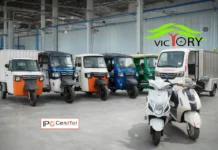As Indo Farm Equipment prepares for its IPO, investors have the opportunity to delve into a company with a two-decade history of manufacturing excellence and consistent growth. This detailed analysis highlights key aspects of the company’s operations, financial health, and market position, offering critical insights for potential investors about the Indo Farm IPO review.

Table of Contents
#1 Indo Farm IPO Review: Core Business and Manufacturing Capabilities
Founded in 1994, Indo Farm Equipment has spent the last 20 years building expertise in tractors and pick-and-carry cranes. Though the company also makes harvester combines and rotavators, these contribute less to its bottom line. Tractors and cranes are where the bulk of the revenues lie—a clear sign of a streamlined, focused business model.
Its manufacturing facilities in Baddi, Himachal Pradesh, spread over a sprawling 1,27,840 square meters, deserve a closer look. These units are ISO 9001:2015 certified and equipped with cutting-edge technology—from induction furnaces and automatic molding lines to dedicated machining, fabrication, painting, and assembly shops. Simply put, Indo Farm has created an operational setup that keeps quality in-house. It produces over 330 tractor components and 190 crane components independently, limiting reliance on external suppliers and keeping costs in check.
#2 Indo Farm IPO Analysis: Production Capacity and Product Lineup
As of 30 September 2024, Indo Farm’s production capacity stands at 12,000 tractors and 1,280 cranes annually. That’s not all—plans are already in motion to boost crane production by another 3,600 units per year. The move signals strategic thinking and a readiness to capitalize on rising demand.
Its tractors, ranging from 16 HP to 110 HP, address around 80% of the global market’s needs. The larger models, especially in the 65–110 HP range, are custom-built for export markets. On the industrial side, Indo Farm’s cranes, with capacities from 9 tons to 30 tons, cater to industries like mining, construction, and infrastructure. The balance of efficiency, safety, and affordability gives these products a competitive edge.
#3 Indo Farm IPO Review: Offer Details
Mark your calendars—the Indo Farm IPO opens on 31 December 2024 and closes on 2 January 2025. Trading begins on 7 January 2025.
The offering combines an Offer for Sale (OFS) of 35,00,000 shares and a Fresh Issue of 86,00,000 shares, totalling INR 246.84–260.15 crore. Investors can bid for a minimum lot of 69 shares, valued at INR 14,835. A healthy 35% chunk is reserved for retail investors, and the IPO will list on both the BSE and NSE.
Read Also: Hero FinCorp IPO: 10 Key Points Investors Should Know
#4 Indo Farm IPO Review: Financial Performance & Margins
Indo Farm’s financials paint a picture of stability and incremental growth. Between FY 2022 and FY 2024, the company’s revenue climbed at a CAGR of 3.24%. Here’s how the numbers stack up:
| FY 2022 | FY 2023 | FY 2024 | Q1 FY 2025 | |
| Revenue | 352.08 | 370.76 | 375.23 | 74.96 |
| Expenses | 333.34 | 349.57 | 352.06 | 71.79 |
| Net income | 13.72 | 15.37 | 15.60 | 2.45 |
| Margin (%) | 3.90 | 4.15 | 4.16 | 3.27 |
Margins tell their own story. EBITDA climbed from 14.79% in FY 2022 to 16.66% in FY 2024, reflecting operational efficiencies. Debt management has also improved, with the Debt-to-Equity ratio dropping from 1.00 in FY 2022 to 0.85 in FY 2024. Solid footing, indeed.
#5 Indo Farm IPO Analysis: Export Contributions and Global Reach
Though domestic sales dominate, contributing 93% of revenue, Indo Farm isn’t ignoring the global market. The company ships products to Europe, Africa, the Middle East, and Asia. Markets like Belgium, Germany, and Kenya have responded well to export-specific models such as the 26 HP tractors designed to meet European standards. While international sales still make up a modest share, the foundation for expansion is already in place.
#6 Indo Farm IPO Review: Backward Integration and R&D Strength
Indo Farm’s strategy for cost control and quality management centres around backward integration. It manufactures vital components—cylinder blocks, gearboxes, and hydraulic winches—within its facilities. This independence sets it apart from competitors who outsource extensively.
R&D is another standout feature. The company’s in-house engineers focus on innovations like re-entrant combustion chamber designs that enhance fuel efficiency. These tech advancements not only improve performance but also prepare the company for stricter emission regulations down the road.
Read Also: Unimech Aerospace IPO Review: 10 Key Points Investors Should Know
#7 Financing Arm: Barota Finance Limited
Launched in 2017, Indo Farm’s NBFC subsidiary, Barota Finance, simplifies the financing process for buyers. As of June 2024, it boasts a loan book worth INR 127.16 crore and serves over 5,900 active customers. Gross NPAs stand at 4.13%, while net NPAs are 3.00%—a healthy range indicating well-managed risk.
#8 Indo Farm IPO Analysis: Dealer Network and Sector-Specific Demand
Indo Farm’s network of 175 dealers spans key agricultural hubs like Punjab, Haryana, Maharashtra, and Uttar Pradesh. This widespread reach boosts visibility and market penetration.
The company’s cranes and tractors cater to sectors such as infrastructure, mining, and agriculture. With these industries expected to grow, Indo Farm appears well-positioned to ride the wave.
#9 Indo Farm IPO Review: Competitive Strengths
- Integrated Manufacturing: Self-reliant production keeps costs down and ensures quality
- Diverse Product Portfolio: From compact 16 HP tractors to heavy-duty 110 HP models, Indo Farm offers flexibility across markets.
- Financial Partnerships: Collaboration with banks like HDFC, Kotak Mahindra, and ICICI boosts accessibility for customers.
#10 Indo Farm IPO Analysis: Challenges and Risks
No company is without hurdles, and Indo Farm is no exception:
- Export Reliance: Exports currently make up only 7% of revenue, leaving room for improvement.
- Competitive Landscape: The tractor and crane markets are crowded with well-established players.
- Economic Sensitivity: Demand is tied to agriculture and infrastructure cycles, making performance vulnerable to slowdowns.
Final Takeaway
Indo Farm Equipment presents a compelling case for investors with its strong manufacturing backbone, consistent profitability, and forward-thinking strategies. Its NBFC arm, operational efficiency, and R&D initiatives add depth to its appeal.
However, challenges like export dependency and market competition can’t be ignored. That said, Indo Farm’s steady growth, manageable debt, and ambitious expansion plans suggest it’s a stock worth watching—especially for those eyeing the agriculture and industrial equipment sectors.




































